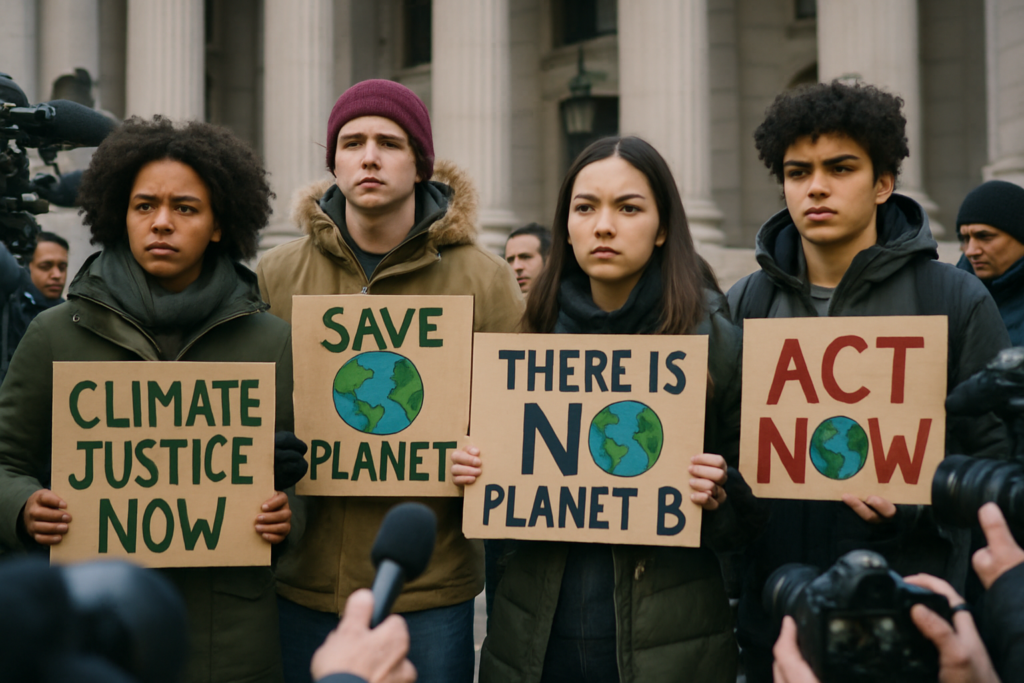Juliana v. United States Ends at Supreme Court: Youth Climate Litigation and Constitutional Rights
The long-running legal battle in Juliana v. United States—a landmark youth climate change lawsuit—has reached a pivotal conclusion. After ten years of legal struggle, the U.S. Supreme Court declined to hear an appeal brought by 21 young climate activists. The plaintiffs contended that the federal government’s energy policies violated their constitutional rights by promoting fossil fuels, directly endangering their health and futures.
On March 24, 2025, the Supreme Court quietly closed the book on Juliana by declining the appeal, putting a procedural stop to a case that has galvanized a generation of environmental activists. As reported, the Supreme Court’s decision drew disappointment from the plaintiffs and their advocates but was welcomed by the U.S. Department of Justice, which had opposed the lawsuit across three presidential administrations (including both Democratic and Republican leadership).
At the heart of this case was the contention that the government’s active support of fossil fuel development and consumption violated fundamental constitutional protections. The 9th U.S. Circuit Court of Appeals had previously held that the courts did not have authority to direct federal energy policy, emphasizing that such decisions belong to the elected branches of government.
“We are fighting for our future, and the court has let us down,” said a 19-year-old plaintiff from Alaska, echoing the sense of loss felt by many watching this case unfold.
Despite this setback, the urgency of the climate crisis remains paramount, and the struggle for climate justice continues to evolve. The Supreme Court’s response, while conclusive domestically, does not silence the surging momentum of youth climate advocacy in the United States and beyond.
Youth Activism and Global Legal Strategies for Climate Accountability
The dismissal of Juliana has not derailed the broader movement. Rather, it has sparked energy and ambition in climate justice efforts worldwide. Since the case’s inception in 2015, it has acted as a catalyst for over 60 similar youth-led climate lawsuits in countries across the globe, according to detailed reporting on its impact. Some of these lawsuits have achieved incremental successes, including landmark decisions in Canada and Germany, where courts have recognized the government’s duty to protect citizens from the harms caused by unchecked climate change.
Legal advocates are now considering international legal forums for climate accountability, underscoring the case’s influence beyond U.S. borders. Julia Olson, lead attorney for the Juliana plaintiffs and founder of Our Children’s Trust, emphasized that the end of the court proceedings does not blunt the urgency of climate advocacy. Olson has signaled that international bodies, such as the United Nations, may be next on the agenda for pushing government accountability.
The case’s impact as a “spark” for the global youth-led movement is hard to overstate. Young activists, inspired by the Juliana plaintiffs’ resilience, have staged climate strikes, demonstrations, and lobbying efforts that have reached the steps of legislatures from Sacramento to Stockholm. The plaintiffs’ demand—that the government recognize and act on the climate crisis—has become a rallying cry for equity and bold action.
“The challenge we face is so large that it requires all hands on deck—individuals, communities, and governments,” Olson said, reinforcing the idea that every effort matters in the climate struggle.
As national courtrooms present new obstacles, the progressive movement for climate justice is seeking change at every level: local, national, and global. Many activists assert that the Juliana case illustrates how creative legal advocacy and collective mobilization can set powerful precedents, even when immediate victories prove elusive.
Policy, Political Branches, and the Path Ahead for U.S. Climate Law
Within the United States, the Supreme Court’s refusal to hear the Juliana appeal underlines a legal perspective that climate and energy policy are mainly the province of the legislative and executive branches, not the judiciary. The Department of Justice, representing the federal government, argued successfully that the courts lack authority to direct national energy policy, a position echoed in the 9th Circuit’s earlier opinion.
While the separation of powers is central to the American legal framework, this outcome also highlights the limitations of relying on litigation alone to achieve systemic change. The decision affirms that the path for climate solutions in the U.S. runs squarely through the halls of Congress and the actions of the executive branch. This means that ongoing advocacy, voting, and policymaking are crucial arenas for progress.
Many legal scholars and environmental advocates suggest that, even though the Supreme Court’s decision seems like a loss, it brings much-needed attention to the need for strong legislative and regulatory action. For example, progressives have called for a renewed push in Congress for bold climate policy—whether through a reinvigorated Green New Deal, carbon taxes, or strict federal limits on greenhouse gas emissions.
The impact of Juliana has extended well beyond the courtroom, propelling a youth-driven movement that continues to shape climate advocacy and public policy debates.
The search for lasting solutions remains firmly alive. Policymakers, community leaders, and young advocates are turning their focus toward building broad-based coalitions, supporting science-based climate policies, and pressing for equity-driven reforms that address both the causes and impacts of the climate crisis. Compared to the beginning of the case, the public is more aware, the youth movement more organized, and the global network for action more connected—and that is, in itself, a foundation for hope.


